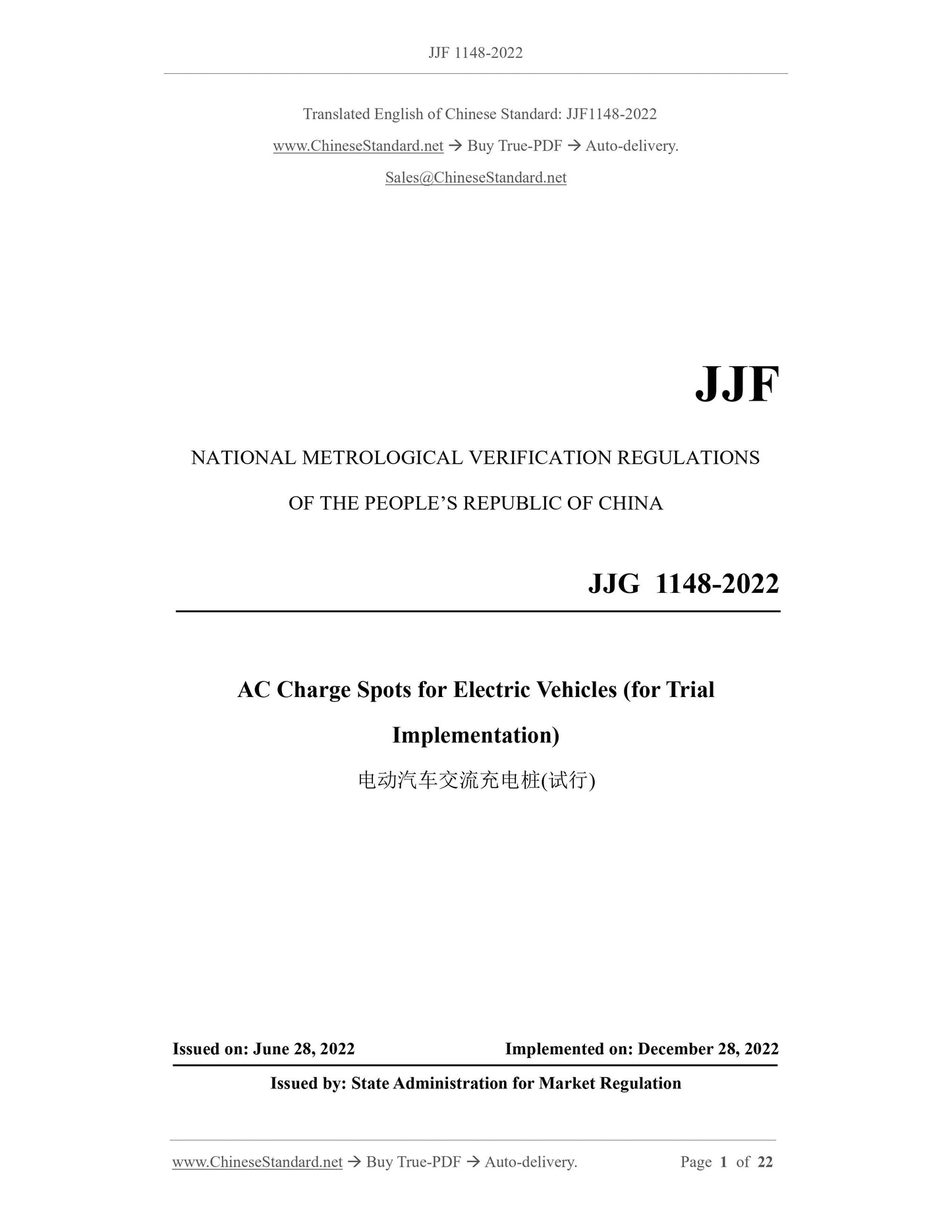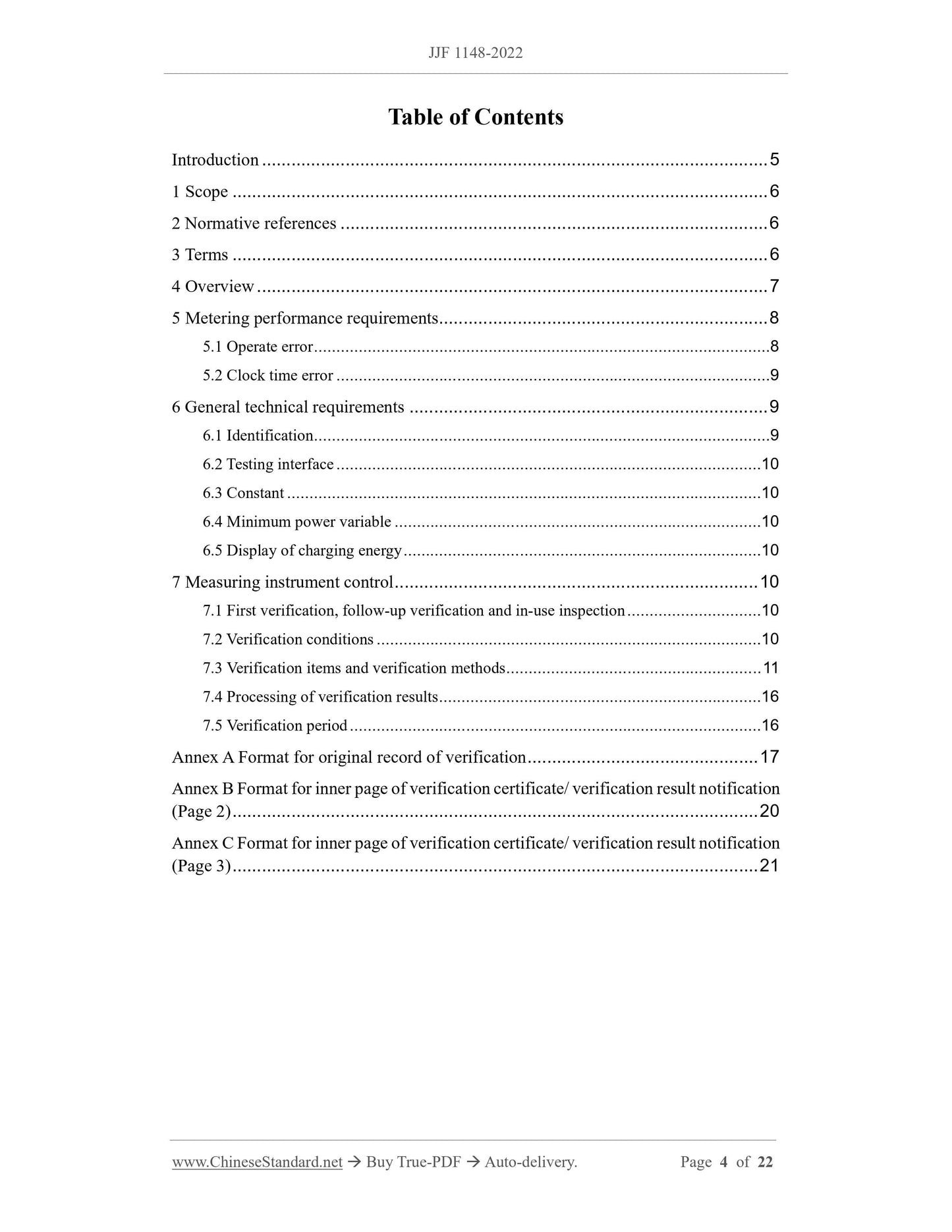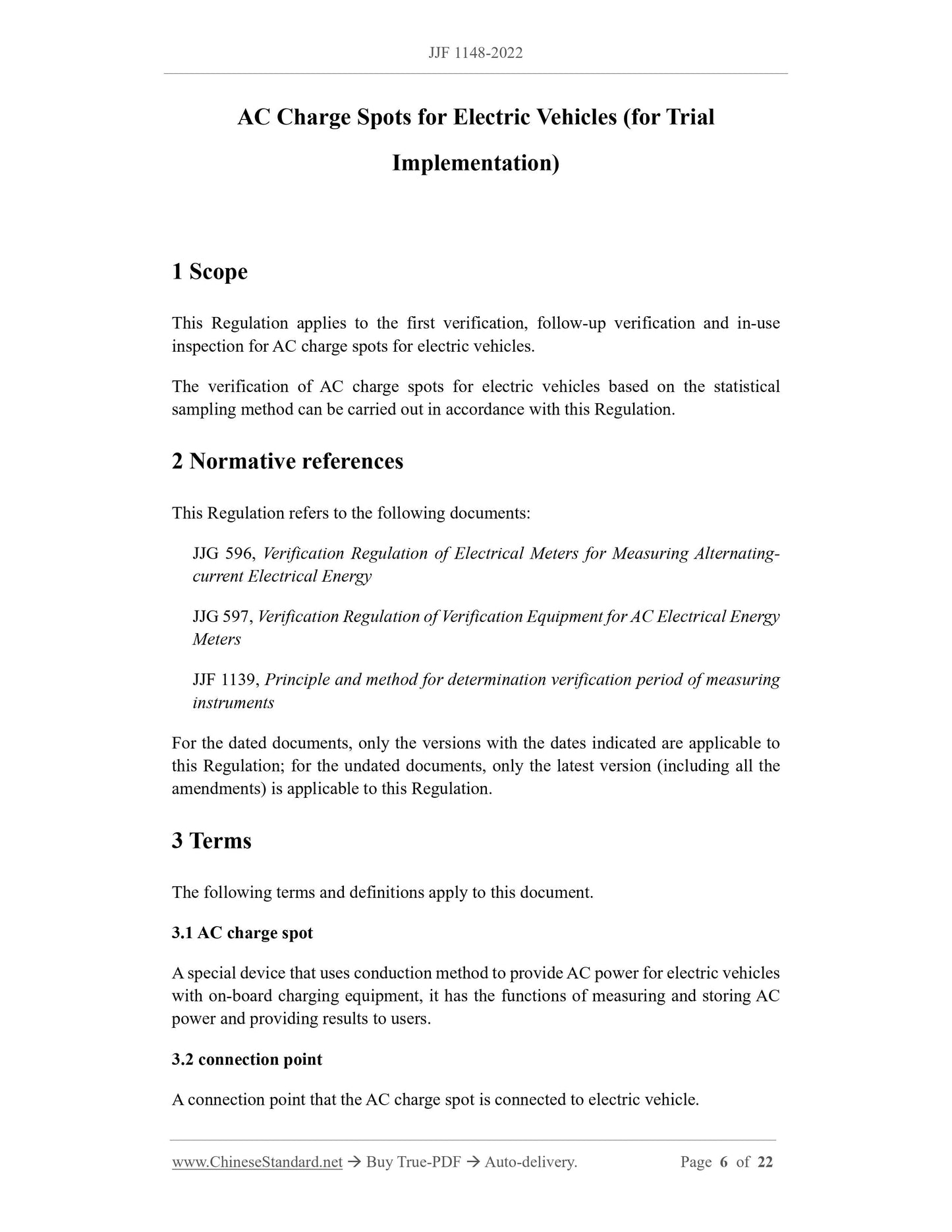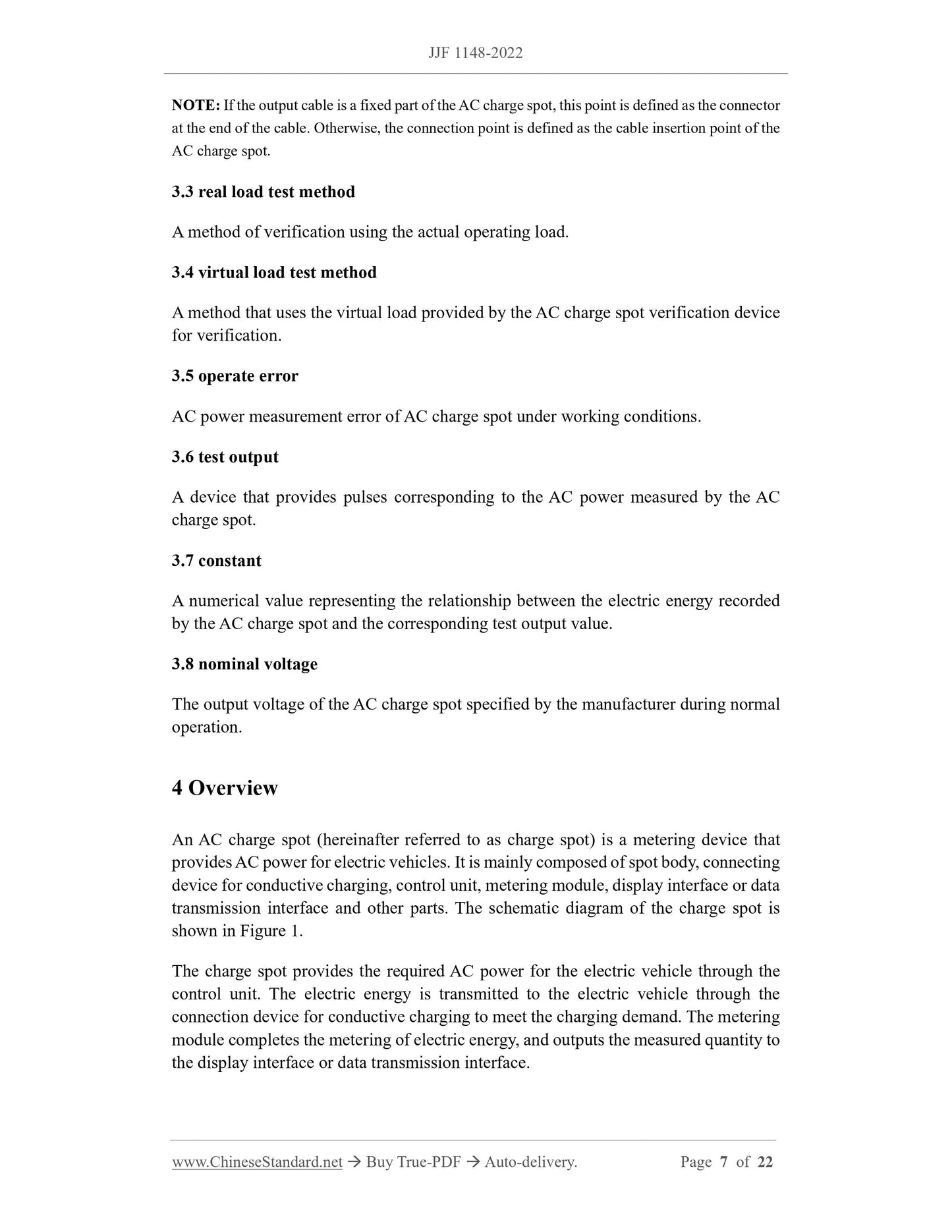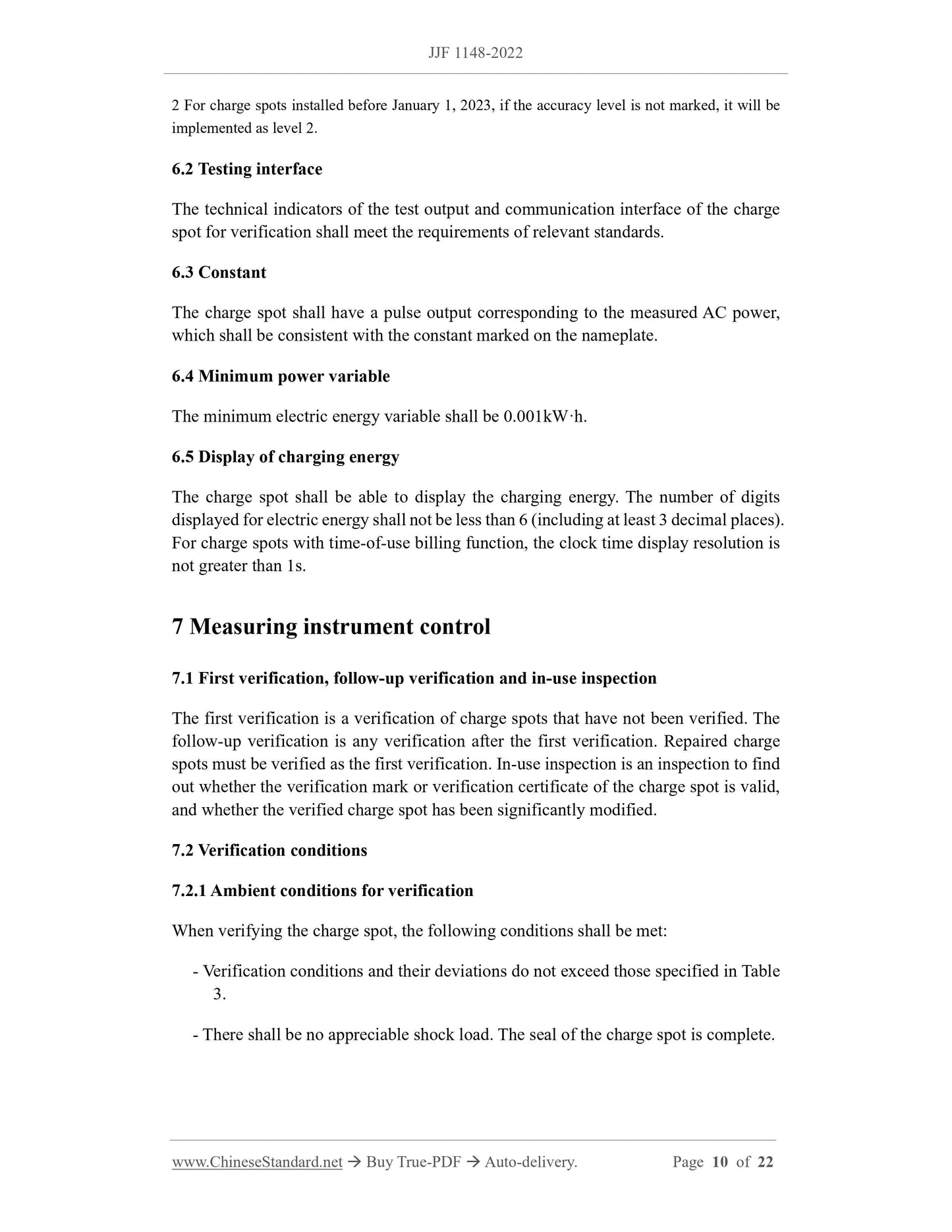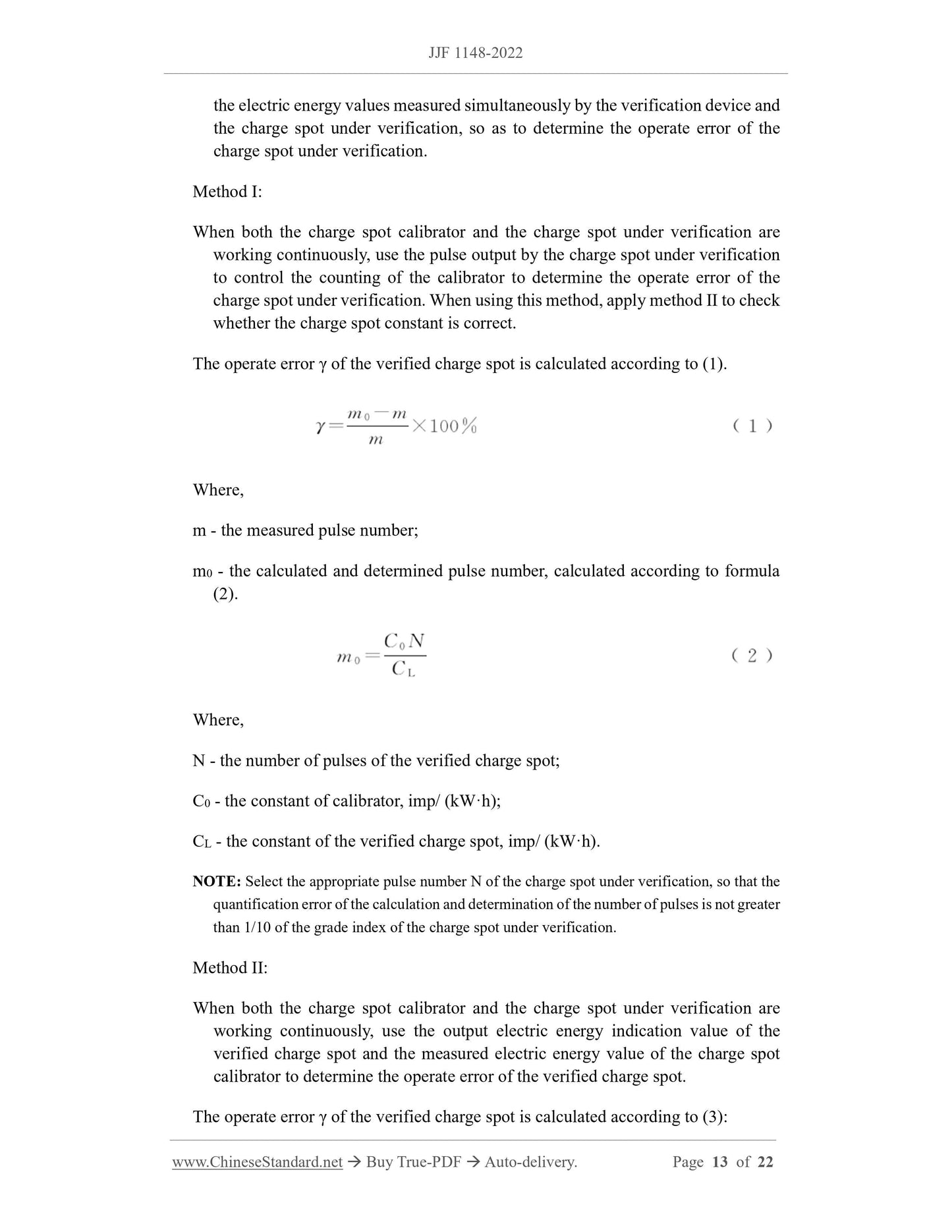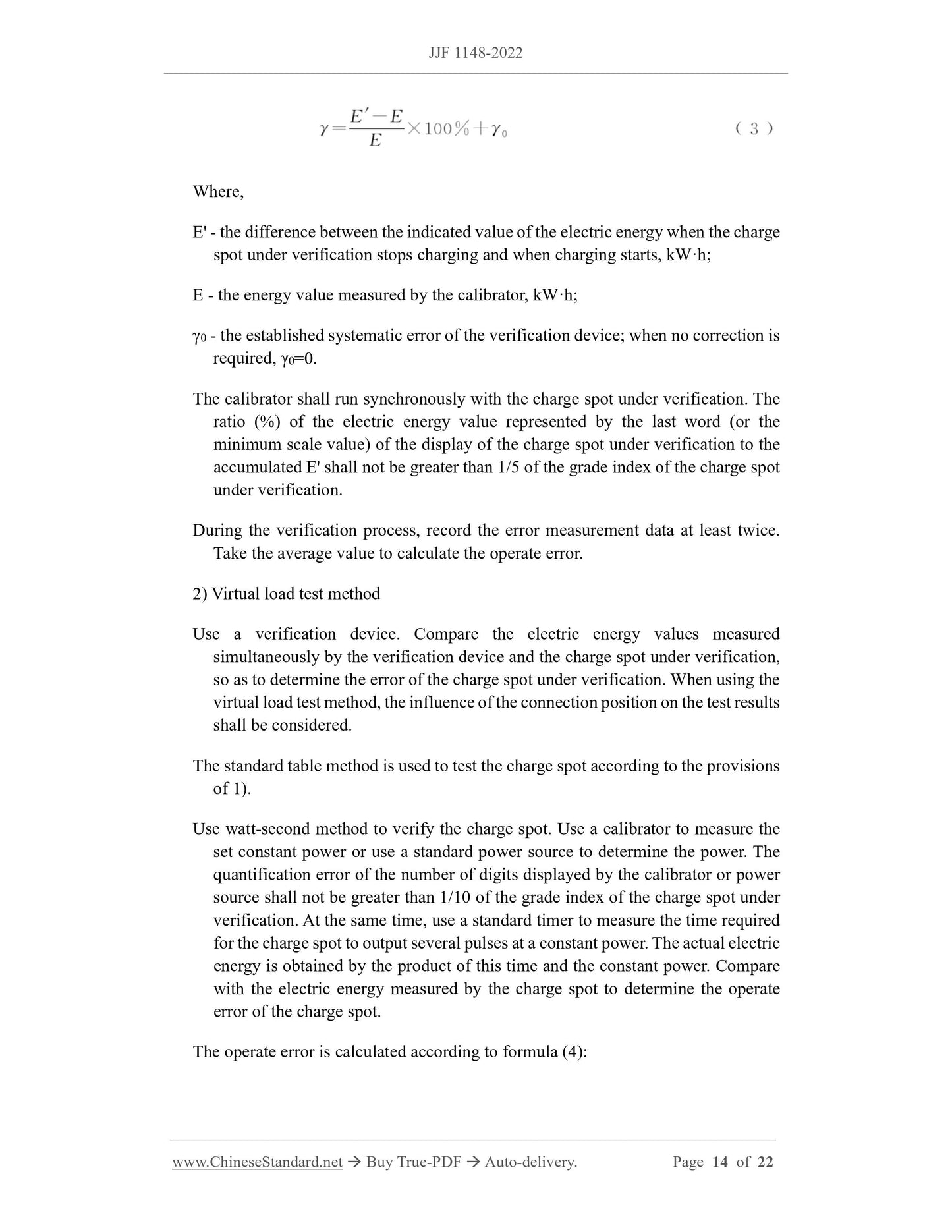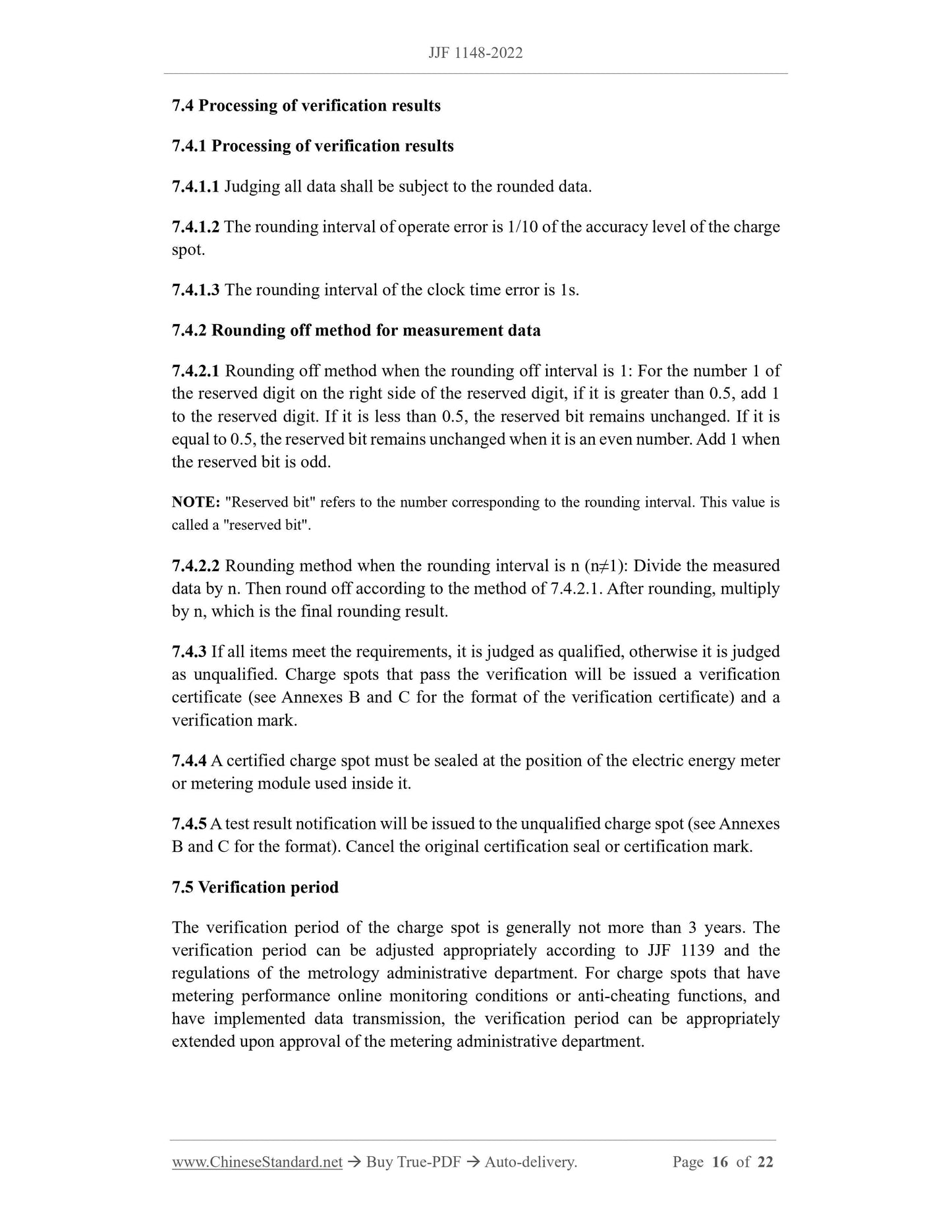1
/
of
8
www.ChineseStandard.us -- Field Test Asia Pte. Ltd.
JJG 1148-2022 English PDF
JJG 1148-2022 English PDF
Regular price
$260.00
Regular price
Sale price
$260.00
Unit price
/
per
Shipping calculated at checkout.
Couldn't load pickup availability
JJG 1148-2022: AC Charge Spots for Electric Vehicles(for Trial Implementation)
Delivery: 9 seconds. Download (& Email) true-PDF + Invoice.
Get Quotation: Click JJG 1148-2022 (Self-service in 1-minute)
Historical versions (Master-website): JJG 1148-2022
Preview True-PDF (Reload/Scroll-down if blank)
JJF 1148-2022
JJF
NATIONAL METROLOGICAL VERIFICATION REGULATIONS
OF THE PEOPLE’S REPUBLIC OF CHINA
JJG 1148-2022
AC Charge Spots for Electric Vehicles (for Trial
Implementation)
ISSUED ON: JUNE 28, 2022
IMPLEMENTED ON: DECEMBER 28, 2022
Issued by: State Administration for Market Regulation
Table of Contents
Introduction ... 5
1 Scope ... 6
2 Normative references ... 6
3 Terms ... 6
4 Overview ... 7
5 Metering performance requirements ... 8
5.1 Operate error ... 8
5.2 Clock time error ... 9
6 General technical requirements ... 9
6.1 Identification ... 9
6.2 Testing interface ... 10
6.3 Constant ... 10
6.4 Minimum power variable ... 10
6.5 Display of charging energy ... 10
7 Measuring instrument control ... 10
7.1 First verification, follow-up verification and in-use inspection ... 10
7.2 Verification conditions ... 10
7.3 Verification items and verification methods ... 11
7.4 Processing of verification results ... 16
7.5 Verification period ... 16
Annex A Format for original record of verification ... 17
Annex B Format for inner page of verification certificate/ verification result notification
(Page 2) ... 20
Annex C Format for inner page of verification certificate/ verification result notification
(Page 3) ... 21
AC Charge Spots for Electric Vehicles (for Trial
Implementation)
1 Scope
This Regulation applies to the first verification, follow-up verification and in-use
inspection for AC charge spots for electric vehicles.
The verification of AC charge spots for electric vehicles based on the statistical
sampling method can be carried out in accordance with this Regulation.
2 Normative references
This Regulation refers to the following documents:
JJG 596, Verification Regulation of Electrical Meters for Measuring Alternating-
current Electrical Energy
JJG 597, Verification Regulation of Verification Equipment for AC Electrical Energy
Meters
JJF 1139, Principle and method for determination verification period of measuring
instruments
For the dated documents, only the versions with the dates indicated are applicable to
this Regulation; for the undated documents, only the latest version (including all the
amendments) is applicable to this Regulation.
3 Terms
The following terms and definitions apply to this document.
3.1 AC charge spot
A special device that uses conduction method to provide AC power for electric vehicles
with on-board charging equipment, it has the functions of measuring and storing AC
power and providing results to users.
3.2 connection point
A connection point that the AC charge spot is connected to electric vehicle.
NOTE: If the output cable is a fixed part of the AC charge spot, this point is defined as the connector
at the end of the cable. Otherwise, the connection point is defined as the cable insertion point of the
AC charge spot.
3.3 real load test method
A method of verification using the actual operating load.
3.4 virtual load test method
A method that uses the virtual load provided by the AC charge spot verification device
for verification.
3.5 operate error
AC power measurement error of AC charge spot under working conditions.
3.6 test output
A device that provides pulses corresponding to the AC power measured by the AC
charge spot.
3.7 constant
A numerical value representing the relationship between the electric energy recorded
by the AC charge spot and the corresponding test output value.
3.8 nominal voltage
The output voltage of the AC charge spot specified by the manufacturer during normal
operation.
4 Overview
An AC charge spot (hereinafter referred to as charge spot) is a metering device that
provides AC power for electric vehicles. It is mainly composed of spot body, connecting
device for conductive charging, control unit, metering module, display interface or data
transmission interface and other parts. The schematic diagram of the charge spot is
shown in Figure 1.
The charge spot provides the required AC power for the electric vehicle through the
control unit. The electric energy is transmitted to the electric vehicle through the
connection device for conductive charging to meet the charging demand. The metering
module completes the metering of electric energy, and outputs the measured quantity to
the display interface or data transmission interface.
2 For charge spots installed before January 1, 2023, if the accuracy level is not marked, it will be
implemented as level 2.
6.2 Testing interface
The technical indicators of the test output and communication interface of the charge
spot for verification shall meet the requirements of relevant standards.
6.3 Constant
The charge spot shall have a pulse output corresponding to the measured AC power,
which shall be consistent with the constant marked on the nameplate.
6.4 Minimum power variable
The minimum electric energy variable shall be 0.001kW·h.
6.5 Display of charging energy
The charge spot shall be able to display the charging energy. The number of digits
displayed for electric energy shall not be less than 6 (including at least 3 decimal places).
For charge spots with time-of-use billing function, the clock time display resolution is
not greater than 1s.
7 Measuring instrument control
7.1 First verification, follow-up verification and in-use inspection
The first verification is a verification of charge spots that have not been verified. The
follow-up verification is any verification after the first verification. Repaired charge
spots must be verified as the first verification. In-use inspection is an inspection to find
out whether the verification mark or verification certificate of the charge spot is valid,
and whether the verified charge spot has been significantly modified.
7.2 Verification conditions
7.2.1 Ambient conditions for verification
When verifying the charge spot, the following conditions shall be met:
- Verification conditions and their deviations do not exceed those specified in Table
3.
- There shall be no appreciable shock load. The seal of the charge spot is complete.
the electric energy values measured simultaneously by the verification device and
the charge spot under verification, so as to determine the operate error of the
charge spot under verification.
Method I:
When both the charge spot calibrator and the charge spot under verification are
working continuously, use the pulse output by the charge spot under verification
to control the counting of the calibrator to determine the operate error of the
charge spot under verification. When using this method, apply method II to check
whether the charge spot constant is correct.
The operate error γ of the verified charge spot is calculated according to (1).
Where,
m - the measured pulse number;
m0 - the calculated and determined pulse number, calculated according to formula
(2).
Where,
N - the number of pulses of the verified charge spot;
C0 - the constant of calibrator, imp/ (kW·h);
CL - the constant of the verified charge spot, imp/ (kW·h).
NOTE: Select the appropriate pulse number N of the charge spot under verification, so that the
quantification error of the calculation and determination of the number of pulses is not greater
than 1/10 of the grade index of the charge spot under verification.
Method II:
When both the charge spot calibrator and the charge spot under verification are
working continuously, use the output electric energy indication value of the
verified charge spot and the measured electric energy value of the charge spot
calibrator to determine the operate error of the verified charge spot.
The operate error γ of the verified charge spot is calculated according to (3):
Where,
E' - the difference between the indicated value of the electric energy when the charge
spot under verification stops charging and when charging starts, kW·h;
E - the energy value measured by the calibrator, kW·h;
γ0 - the established systematic error of the verification device; when no correction is
required, γ0=0.
The calibrator shall run synchronously with the charge spot under verification. The
ratio (%) of the electric energy value represented by the last word (or the
minimum scale value) of the display of the charge spot under verification to the
accumulated E' shall not be greater than 1/5 of the grade index of the charge spot
under verification.
During the verification process, record the error measurement data at least twice.
Take the average value to calculate the operate error.
2) Virtual load test method
Use a verification device. Compare the electric energy values measured
simultaneously by the verification device and the charge spot under verification,
so as to determine the error of the charge spot under verification. When using the
virtual load test method, the influence of the connection position on the test results
shall be considered.
The standard table method is used to test the charge spot according to the provisions
of 1).
Use watt-second method to verify the charge spot. Use a calibrator to measure the
set constant power or use a standard power source to determine the power. The
quantification error of the number of digits displayed by the calibrator or power
source shall not be greater than 1/10 of the grade index of the charge spot under
verification. At the same time, use a standard timer to measure the time required
for the charge spot to output several pulses at a constant power. The actual electric
energy is obtained by the product of this time and the constant power. Compare
with the electric energy measured by the charge spot to determine the operate
error of the charge spot.
The operate error is calculated according to formula (4):
7.4 Processing of verification results
7.4.1 Processing of verification results
7.4.1.1 Judging all data shall be subject to the rounded data.
7.4.1.2 The rounding interval of operate error is 1/10 of the accuracy level of the charge
spot.
7.4.1.3 The rounding interval of the clock time error is 1s.
7.4.2 Rounding off method for measurement data
7.4.2.1 Rounding off method when the rounding off interval is 1: For the number 1 of
the reserved digit on the right side of the reserved digit, if it is greater than 0.5, add 1
to the reserved digit. If it is less than 0.5, the reserved bit remains unchanged. If it is
equal to 0.5, the reserved bit remains unchanged when it is an even number. Add 1 when
the reserved bit is odd.
NOTE: "Reserved bit" refers to the number corresponding to the rounding interval. This value is
called a "reserved bit".
7.4.2.2 Rounding method when the rounding interval is n (n≠1): Divide the measured
data by n. Then round off according to the method of 7.4.2.1. After rounding, multiply
by n, which is the final rounding result.
7.4.3 If all items meet the requirements, it is judged as qualified, otherwise it is judged
as unqualified. Charge spots that pass the verification will be issued a verification
certificate (see Annexes B and C for the format of the verification certificate) and a
verification mark.
7.4.4 A certified charge spot must be sealed at the position of the electric energy meter
or metering module used inside it.
7.4.5 A test result notification will be issued to the unqualified charge spot (see Annexes
B and C for the format). Cancel the original certification seal or certification mark.
7.5 Verification period
The verification period of the charge spot is generally not more than 3 years. The
verification period can be adjusted appropriately according to JJF 1139 and the
regulations of the metrology administrative department. For charge spots that have
metering performance online monitoring conditions or anti-cheating functions, and
have implemented data transmission, the verification period can be appropriately
extended upon approval of the metering administrative department.
JJF 1148-2022
JJF
NATIONAL METROLOGICAL VERIFICATION REGULATIONS
OF THE PEOPLE’S REPUBLIC OF CHINA
JJG 1148-2022
AC Charge Spots for Electric Vehicles (for Trial
Implementation)
ISSUED ON: JUNE 28, 2022
IMPLEMENTED ON: DECEMBER 28, 2022
Issued by: State Administration for Market Regulation
Table of Contents
Introduction ... 5
1 Scope ... 6
2 Normative references ... 6
3 Terms ... 6
4 Overview ... 7
5 Metering performance requirements ... 8
5.1 Operate error ... 8
5.2 Clock time error ... 9
6 General technical requirements ... 9
6.1 Identification ... 9
6.2 Testing interface ... 10
6.3 Constant ... 10
6.4 Minimum power variable ... 10
6.5 Display of charging energy ... 10
7 Measuring instrument control ... 10
7.1 First verification, follow-up verification and in-use inspection ... 10
7.2 Verification conditions ... 10
7.3 Verification items and verification methods ... 11
7.4 Processing of verification results ... 16
7.5 Verification period ... 16
Annex A Format for original record of verification ... 17
Annex B Format for inner page of verification certificate/ verification result notification
(Page 2) ... 20
Annex C Format for inner page of verification certificate/ verification result notification
(Page 3) ... 21
AC Charge Spots for Electric Vehicles (for Trial
Implementation)
1 Scope
This Regulation applies to the first verification, follow-up verification and in-use
inspection for AC charge spots for electric vehicles.
The verification of AC charge spots for electric vehicles based on the statistical
sampling method can be carried out in accordance with this Regulation.
2 Normative references
This Regulation refers to the following documents:
JJG 596, Verification Regulation of Electrical Meters for Measuring Alternating-
current Electrical Energy
JJG 597, Verification Regulation of Verification Equipment for AC Electrical Energy
Meters
JJF 1139, Principle and method for determination verification period of measuring
instru...
Delivery: 9 seconds. Download (& Email) true-PDF + Invoice.
Get Quotation: Click JJG 1148-2022 (Self-service in 1-minute)
Historical versions (Master-website): JJG 1148-2022
Preview True-PDF (Reload/Scroll-down if blank)
JJF 1148-2022
JJF
NATIONAL METROLOGICAL VERIFICATION REGULATIONS
OF THE PEOPLE’S REPUBLIC OF CHINA
JJG 1148-2022
AC Charge Spots for Electric Vehicles (for Trial
Implementation)
ISSUED ON: JUNE 28, 2022
IMPLEMENTED ON: DECEMBER 28, 2022
Issued by: State Administration for Market Regulation
Table of Contents
Introduction ... 5
1 Scope ... 6
2 Normative references ... 6
3 Terms ... 6
4 Overview ... 7
5 Metering performance requirements ... 8
5.1 Operate error ... 8
5.2 Clock time error ... 9
6 General technical requirements ... 9
6.1 Identification ... 9
6.2 Testing interface ... 10
6.3 Constant ... 10
6.4 Minimum power variable ... 10
6.5 Display of charging energy ... 10
7 Measuring instrument control ... 10
7.1 First verification, follow-up verification and in-use inspection ... 10
7.2 Verification conditions ... 10
7.3 Verification items and verification methods ... 11
7.4 Processing of verification results ... 16
7.5 Verification period ... 16
Annex A Format for original record of verification ... 17
Annex B Format for inner page of verification certificate/ verification result notification
(Page 2) ... 20
Annex C Format for inner page of verification certificate/ verification result notification
(Page 3) ... 21
AC Charge Spots for Electric Vehicles (for Trial
Implementation)
1 Scope
This Regulation applies to the first verification, follow-up verification and in-use
inspection for AC charge spots for electric vehicles.
The verification of AC charge spots for electric vehicles based on the statistical
sampling method can be carried out in accordance with this Regulation.
2 Normative references
This Regulation refers to the following documents:
JJG 596, Verification Regulation of Electrical Meters for Measuring Alternating-
current Electrical Energy
JJG 597, Verification Regulation of Verification Equipment for AC Electrical Energy
Meters
JJF 1139, Principle and method for determination verification period of measuring
instruments
For the dated documents, only the versions with the dates indicated are applicable to
this Regulation; for the undated documents, only the latest version (including all the
amendments) is applicable to this Regulation.
3 Terms
The following terms and definitions apply to this document.
3.1 AC charge spot
A special device that uses conduction method to provide AC power for electric vehicles
with on-board charging equipment, it has the functions of measuring and storing AC
power and providing results to users.
3.2 connection point
A connection point that the AC charge spot is connected to electric vehicle.
NOTE: If the output cable is a fixed part of the AC charge spot, this point is defined as the connector
at the end of the cable. Otherwise, the connection point is defined as the cable insertion point of the
AC charge spot.
3.3 real load test method
A method of verification using the actual operating load.
3.4 virtual load test method
A method that uses the virtual load provided by the AC charge spot verification device
for verification.
3.5 operate error
AC power measurement error of AC charge spot under working conditions.
3.6 test output
A device that provides pulses corresponding to the AC power measured by the AC
charge spot.
3.7 constant
A numerical value representing the relationship between the electric energy recorded
by the AC charge spot and the corresponding test output value.
3.8 nominal voltage
The output voltage of the AC charge spot specified by the manufacturer during normal
operation.
4 Overview
An AC charge spot (hereinafter referred to as charge spot) is a metering device that
provides AC power for electric vehicles. It is mainly composed of spot body, connecting
device for conductive charging, control unit, metering module, display interface or data
transmission interface and other parts. The schematic diagram of the charge spot is
shown in Figure 1.
The charge spot provides the required AC power for the electric vehicle through the
control unit. The electric energy is transmitted to the electric vehicle through the
connection device for conductive charging to meet the charging demand. The metering
module completes the metering of electric energy, and outputs the measured quantity to
the display interface or data transmission interface.
2 For charge spots installed before January 1, 2023, if the accuracy level is not marked, it will be
implemented as level 2.
6.2 Testing interface
The technical indicators of the test output and communication interface of the charge
spot for verification shall meet the requirements of relevant standards.
6.3 Constant
The charge spot shall have a pulse output corresponding to the measured AC power,
which shall be consistent with the constant marked on the nameplate.
6.4 Minimum power variable
The minimum electric energy variable shall be 0.001kW·h.
6.5 Display of charging energy
The charge spot shall be able to display the charging energy. The number of digits
displayed for electric energy shall not be less than 6 (including at least 3 decimal places).
For charge spots with time-of-use billing function, the clock time display resolution is
not greater than 1s.
7 Measuring instrument control
7.1 First verification, follow-up verification and in-use inspection
The first verification is a verification of charge spots that have not been verified. The
follow-up verification is any verification after the first verification. Repaired charge
spots must be verified as the first verification. In-use inspection is an inspection to find
out whether the verification mark or verification certificate of the charge spot is valid,
and whether the verified charge spot has been significantly modified.
7.2 Verification conditions
7.2.1 Ambient conditions for verification
When verifying the charge spot, the following conditions shall be met:
- Verification conditions and their deviations do not exceed those specified in Table
3.
- There shall be no appreciable shock load. The seal of the charge spot is complete.
the electric energy values measured simultaneously by the verification device and
the charge spot under verification, so as to determine the operate error of the
charge spot under verification.
Method I:
When both the charge spot calibrator and the charge spot under verification are
working continuously, use the pulse output by the charge spot under verification
to control the counting of the calibrator to determine the operate error of the
charge spot under verification. When using this method, apply method II to check
whether the charge spot constant is correct.
The operate error γ of the verified charge spot is calculated according to (1).
Where,
m - the measured pulse number;
m0 - the calculated and determined pulse number, calculated according to formula
(2).
Where,
N - the number of pulses of the verified charge spot;
C0 - the constant of calibrator, imp/ (kW·h);
CL - the constant of the verified charge spot, imp/ (kW·h).
NOTE: Select the appropriate pulse number N of the charge spot under verification, so that the
quantification error of the calculation and determination of the number of pulses is not greater
than 1/10 of the grade index of the charge spot under verification.
Method II:
When both the charge spot calibrator and the charge spot under verification are
working continuously, use the output electric energy indication value of the
verified charge spot and the measured electric energy value of the charge spot
calibrator to determine the operate error of the verified charge spot.
The operate error γ of the verified charge spot is calculated according to (3):
Where,
E' - the difference between the indicated value of the electric energy when the charge
spot under verification stops charging and when charging starts, kW·h;
E - the energy value measured by the calibrator, kW·h;
γ0 - the established systematic error of the verification device; when no correction is
required, γ0=0.
The calibrator shall run synchronously with the charge spot under verification. The
ratio (%) of the electric energy value represented by the last word (or the
minimum scale value) of the display of the charge spot under verification to the
accumulated E' shall not be greater than 1/5 of the grade index of the charge spot
under verification.
During the verification process, record the error measurement data at least twice.
Take the average value to calculate the operate error.
2) Virtual load test method
Use a verification device. Compare the electric energy values measured
simultaneously by the verification device and the charge spot under verification,
so as to determine the error of the charge spot under verification. When using the
virtual load test method, the influence of the connection position on the test results
shall be considered.
The standard table method is used to test the charge spot according to the provisions
of 1).
Use watt-second method to verify the charge spot. Use a calibrator to measure the
set constant power or use a standard power source to determine the power. The
quantification error of the number of digits displayed by the calibrator or power
source shall not be greater than 1/10 of the grade index of the charge spot under
verification. At the same time, use a standard timer to measure the time required
for the charge spot to output several pulses at a constant power. The actual electric
energy is obtained by the product of this time and the constant power. Compare
with the electric energy measured by the charge spot to determine the operate
error of the charge spot.
The operate error is calculated according to formula (4):
7.4 Processing of verification results
7.4.1 Processing of verification results
7.4.1.1 Judging all data shall be subject to the rounded data.
7.4.1.2 The rounding interval of operate error is 1/10 of the accuracy level of the charge
spot.
7.4.1.3 The rounding interval of the clock time error is 1s.
7.4.2 Rounding off method for measurement data
7.4.2.1 Rounding off method when the rounding off interval is 1: For the number 1 of
the reserved digit on the right side of the reserved digit, if it is greater than 0.5, add 1
to the reserved digit. If it is less than 0.5, the reserved bit remains unchanged. If it is
equal to 0.5, the reserved bit remains unchanged when it is an even number. Add 1 when
the reserved bit is odd.
NOTE: "Reserved bit" refers to the number corresponding to the rounding interval. This value is
called a "reserved bit".
7.4.2.2 Rounding method when the rounding interval is n (n≠1): Divide the measured
data by n. Then round off according to the method of 7.4.2.1. After rounding, multiply
by n, which is the final rounding result.
7.4.3 If all items meet the requirements, it is judged as qualified, otherwise it is judged
as unqualified. Charge spots that pass the verification will be issued a verification
certificate (see Annexes B and C for the format of the verification certificate) and a
verification mark.
7.4.4 A certified charge spot must be sealed at the position of the electric energy meter
or metering module used inside it.
7.4.5 A test result notification will be issued to the unqualified charge spot (see Annexes
B and C for the format). Cancel the original certification seal or certification mark.
7.5 Verification period
The verification period of the charge spot is generally not more than 3 years. The
verification period can be adjusted appropriately according to JJF 1139 and the
regulations of the metrology administrative department. For charge spots that have
metering performance online monitoring conditions or anti-cheating functions, and
have implemented data transmission, the verification period can be appropriately
extended upon approval of the metering administrative department.
JJF 1148-2022
JJF
NATIONAL METROLOGICAL VERIFICATION REGULATIONS
OF THE PEOPLE’S REPUBLIC OF CHINA
JJG 1148-2022
AC Charge Spots for Electric Vehicles (for Trial
Implementation)
ISSUED ON: JUNE 28, 2022
IMPLEMENTED ON: DECEMBER 28, 2022
Issued by: State Administration for Market Regulation
Table of Contents
Introduction ... 5
1 Scope ... 6
2 Normative references ... 6
3 Terms ... 6
4 Overview ... 7
5 Metering performance requirements ... 8
5.1 Operate error ... 8
5.2 Clock time error ... 9
6 General technical requirements ... 9
6.1 Identification ... 9
6.2 Testing interface ... 10
6.3 Constant ... 10
6.4 Minimum power variable ... 10
6.5 Display of charging energy ... 10
7 Measuring instrument control ... 10
7.1 First verification, follow-up verification and in-use inspection ... 10
7.2 Verification conditions ... 10
7.3 Verification items and verification methods ... 11
7.4 Processing of verification results ... 16
7.5 Verification period ... 16
Annex A Format for original record of verification ... 17
Annex B Format for inner page of verification certificate/ verification result notification
(Page 2) ... 20
Annex C Format for inner page of verification certificate/ verification result notification
(Page 3) ... 21
AC Charge Spots for Electric Vehicles (for Trial
Implementation)
1 Scope
This Regulation applies to the first verification, follow-up verification and in-use
inspection for AC charge spots for electric vehicles.
The verification of AC charge spots for electric vehicles based on the statistical
sampling method can be carried out in accordance with this Regulation.
2 Normative references
This Regulation refers to the following documents:
JJG 596, Verification Regulation of Electrical Meters for Measuring Alternating-
current Electrical Energy
JJG 597, Verification Regulation of Verification Equipment for AC Electrical Energy
Meters
JJF 1139, Principle and method for determination verification period of measuring
instru...
Share
